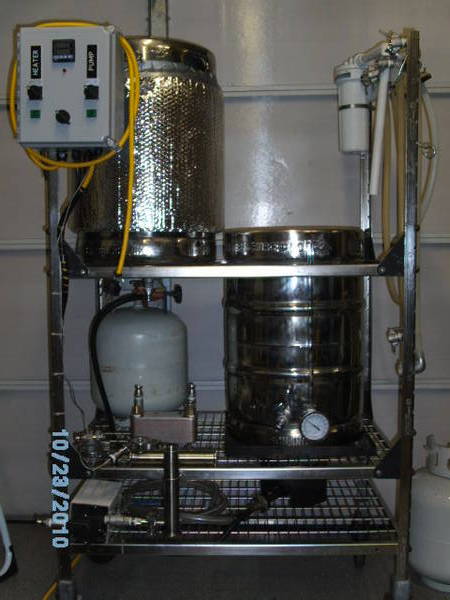JJWP
Well-Known Member
Apologies if this sparging approach is already covered somewhere - I've searched and cannot find anything exactly like this. If it exists and has already been discussed please send me on my way.
So I've been thinking about my new build and I am wondering if it is possible to single temp infusion mash and batch sparge for 5 gallon batches (and maybe low gravity 10 gallon batches) in a converted keg MLT, while doing away with a dedicated HLT entirely.
The setup would basically be this:
1 15.5 gallon MLT +
1 15.5 gallon combo Boil Kettle/HLT +
1 pump
1 burner (heating the BK/HLT)
so, two vessels, single tier.
The process would be something like this -
1. Heat strike water to temp in BK/HLT
2. Pump strike water to MLT and dough in
3. Heat sparge water in BK/MLT
4. Mash out with FULL volume of sparge water - pump into MLT and mix in
5. 5 minute pump powered vorlauf
6. Drain only half of the MLT volume into the now empty BK
7. Stir up remaining half in MLT, and repeat steps 5-6 until full pre-boil volume collected
Now, I suppose the real question here is: how is this approach really that different than a traditional batch sparge where the MLT is basically run nearly dry, a second infusion is added and mixed, the vorlauf is repeated, and a second running taken?
It seems to me that there isn't really any reason to expect any significant drop in efficiency with this approach, and it has the benefit requiring only two vessels. Am I way off here?
Thoughts?
(for 10 gallon batches I suppose I could pull out an 5 gallon bucket to hold some water run through the process twice)
So I've been thinking about my new build and I am wondering if it is possible to single temp infusion mash and batch sparge for 5 gallon batches (and maybe low gravity 10 gallon batches) in a converted keg MLT, while doing away with a dedicated HLT entirely.
The setup would basically be this:
1 15.5 gallon MLT +
1 15.5 gallon combo Boil Kettle/HLT +
1 pump
1 burner (heating the BK/HLT)
so, two vessels, single tier.
The process would be something like this -
1. Heat strike water to temp in BK/HLT
2. Pump strike water to MLT and dough in
3. Heat sparge water in BK/MLT
4. Mash out with FULL volume of sparge water - pump into MLT and mix in
5. 5 minute pump powered vorlauf
6. Drain only half of the MLT volume into the now empty BK
7. Stir up remaining half in MLT, and repeat steps 5-6 until full pre-boil volume collected
Now, I suppose the real question here is: how is this approach really that different than a traditional batch sparge where the MLT is basically run nearly dry, a second infusion is added and mixed, the vorlauf is repeated, and a second running taken?
It seems to me that there isn't really any reason to expect any significant drop in efficiency with this approach, and it has the benefit requiring only two vessels. Am I way off here?
Thoughts?
(for 10 gallon batches I suppose I could pull out an 5 gallon bucket to hold some water run through the process twice)




